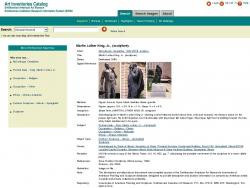Susan Ogilvie's collections
Conflict and Compromise: The Vietnam War
<p>This collection brings together <a href="https://edsitement.neh.gov/">EDSITEment</a> and Smithsonian resources to support the initial research into a project for National History Day 2018, "Conflict and Compromise in History."</p>
<p>These resources - including protest posters, archival photographs, interviews, artwork, and articles - explore the topic of the Vietnam War from multiple perspectives. Resources highlight politics, the experience of soldiers, anti-war protests, and artwork created in reaction to the Vietnam War. The second tile of this collection contains questions to help with both the analysis of this historical event and the analysis of different types of resources (photograph, document, artwork, portrait, and object). The third tile contains a graphic organizer, created by <a href="https://nhd.org/">National History Day</a>, to help explore historical context and the "Conflict and Compromise in History" theme.</p>
<p>By no means is this collection comprehensive; instead, it provides a launching point for further research.<br /></p>
<p>This collection was created in collaboration with <a href="https://edsitement.neh.gov/">EDSITEment</a>, a website for K-12 educators from the National Endowment for the Humanities.</p>
<p>Share your National History Day collections and let us know what you think! Write to us on Twitter: <a href="https://twitter.com/EDSITEment">@EDSITEment</a> & <a href="https://twitter.com/smithsonianlab">@SmithsonianLab</a>, #NHD2018. If you publish a collection on your National History Day topic, be sure to enter #NHD2018 in the description!</p>
<p>Tags: ho chi-minh; lyndon b. johnson; richard nixon; walter cronkite; henry kissinger; veteran; oral history; viet cong; protest; peace; 50s; 60s; 70s; 20th century; 1900s; national endowment for the humanities; nhd; #NHD</p>
 Susan Ogilvie
Susan Ogilvie
84
The 1960s--A Decade Collection
<p>This is a topical collection about American life and politics in the 1960s. Resources in this collection might be helpful to students and teachers working on projects about the decade. It is not meant to be completely comprehensive, but rather includes highlights of the Smithsonian's collection spanning art, popular culture, social trends, leadership, and technology.</p><p>Teachers and students might copy and adapt this collection to suit their needs; highlighting a specific aspect of life in the 1960s and adding annotations and additional resources.</p><p>tags: Sixties, Kennedy, Camelot, civil rights, Vietnam, politics, decade</p>
 Susan Ogilvie
Susan Ogilvie
97
Communes, Counterculture, and the Back to the Land Movement
<p>This collection includes a variety of photographs taken by Lisa Law. Students will examine the photographs and a few artifacts and try to draw conclusions about the ways in which the commune or back-to-the-land movement challenged the norms of traditional United States society in the 1960s and 1970s. A link to an exhibit website is include and allows students to check their assumptions, and students are asked to compare elements of the counterculture with that of mainstream 1960s and 1970s culture. </p><p>Tags: counterculture, commune, hippie, granola, back to nature, communal living, co-op, cooperative, sixties, seventies, Woodstock, change over time, compare, ashram, silent majority</p>
 Susan Ogilvie
Susan Ogilvie
10
The Black Power Movement
<p>Teaching about the Black Power Movement can be challenging, but has rich rewards. Misconceptions about the Black Power Movement abound, but the ability to contrast their strategies and aims with the earlier Civil Rights Movement allows Social Studies teachers to discuss the complex ways that social movements evolve, change, and respond to the times. In addition, a study of the Black Power Movement helps give context for a broader study of the economic and political shifts in the 1970s and 1980s and the rise of identity politics. This teaching collection includes a variety of resources that could be used to teach about the Black Power Movement, organized into sections for:</p><p>-People in the Movement</p><p>-Goals and Strategies of the Movement</p><p>-Teaching Activities</p><p>General guiding questions for this collection include:</p><p>-What were the distinct problems that the Black Power Movement tried to address? Do they remain today?</p><p>-What were the strategies of the Black Power Movement? Do you agree or disagree with these? </p><p>-Why and how do social movements develop and evolve? </p><p>-What defines a successful social movement? Was the Black Power Movement successful?</p><p>- Can a social movement survive beyond the demise of its leadership?</p><p>-What is the role of the arts in promoting the ideals of social movements?</p><p>This is a work-in-progress based on the digitized materials within the Smithsonian Learning Lab's collection--it is not meant to be wholly definitive or authoritative.<br /></p>
 Susan Ogilvie
Susan Ogilvie
31
Access Series: Nostalgic Popular "Pop" Culture 1950s-2000s
<p>This inspiration collection of nostalgic popular "pop" culture from the 1950s, 1960s, 1970s, 1980s, 1990s and 2000s—super heroes and super villains, Muppets, cartoon characters, Star Wars, Disney and Pixar characters, Transformers, and movies was used for a collage activity and discussion prompt in an informal learning activity, "Me & My World: Personal Ecology/Interest Inventory" with a group of teens with cognitive and intellectual disabilities. Students were asked about their favorite pop culture influences from the past and present. Use the visible thinking routine, "See|Think|Wonder" as a starting point for a discussion prompt, and the images for inspiration. </p><p>Tags: decision-making, self-determination, student empowerment, disability, All Access Digital Arts Program</p>
 Susan Ogilvie
Susan Ogilvie
97
Rebels and Beats
<p>This topical collection is based on a past exhibit in the National Portrait Gallery entitled <a href="http://www.npg.si.edu/exh/rebels/index2.htm" target="_blank">Rebels and Beats: Painters and Poets of the 1950s</a>. This collection might be used by teachers or students who want to explore the counterculture of the 1950s, a time period typically associated with conformity. The collection includes paintings, photographs, and videos related to the writers and artists involved in the Beat Generation, San Francisco Renaissance, Black Mountain College, and New York School scenes. </p><p>In what ways did these artists challenge the social norms of the time? Why is art often a means of challenging the status quo?</p><p>tags: Ginsberg, Kerouac, Ferlinghetti, de Kooning, Baraka, poem, counterculture, Beat Movement</p>
 Susan Ogilvie
Susan Ogilvie
43







